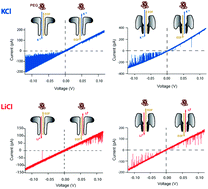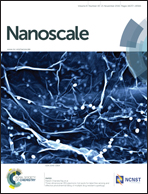Probing driving forces in aerolysin and α-hemolysin biological nanopores: electrophoresis versus electroosmosis†
Abstract
The transport of macromolecules through nanopores is involved in many biological functions and is today at the basis of promising technological applications. Nevertheless the interpretation of the dynamics of the macromolecule/nanopore interaction is still misunderstood and under debate. At the nanoscale, inside biomimetic channels under an external applied voltage, electrophoresis, which is the electric force acting on electrically charged molecules, and electroosmotic flow (EOF), which is the fluid transport associated with ions, contribute to the direction and magnitude of the molecular transport. In order to decipher the contribution of the electrophoresis and electroosmotic flow, we explored the interaction of small, rigid, neutral molecules (cyclodextrins) and flexible, non-ionic polymers (poly(ethylene glycol), PEG) that can coordinate cations under appropriate experimental conditions, with two biological nanopores: aerolysin (AeL) and α-hemolysin (aHL). We performed experiments using two electrolytes with different ionic hydration (KCl and LiCl). Regardless of the nature of the nanopore and of the electrolyte, cyclodextrins behaved as neutral analytes. The dominant driving force was attributed to EOF, acting in the direction of the anion flow and stronger in LiCl than in KCl. The same qualitative behaviour was observed for PEGs in LiCl. In contrast, in KCl, PEGs behaved as positively charged polyelectrolytes through both AeL and aHL. Our results are in agreement with theoretical predictions about the injection of polymers inside a confined geometry (ESI). We believe our results to be of significant importance for better control of the dynamics of analytes of different nature through biological nanopores.


 Please wait while we load your content...
Please wait while we load your content...